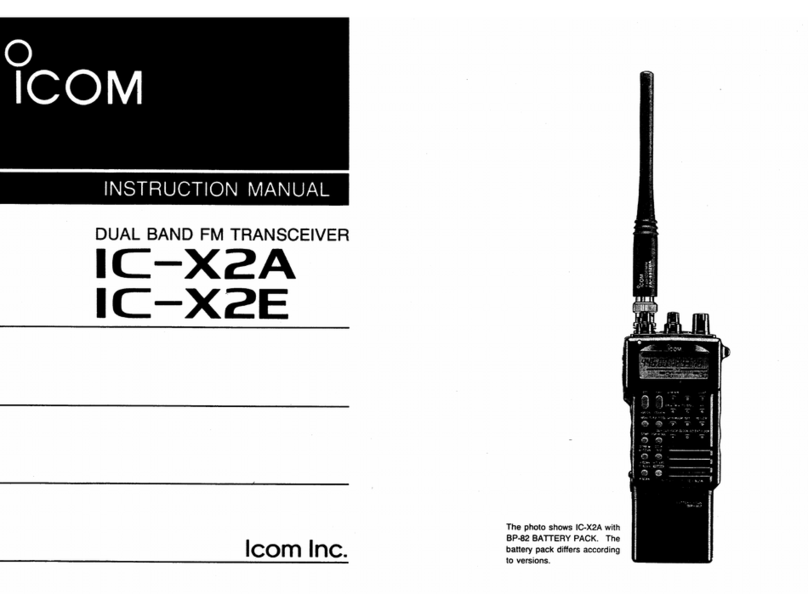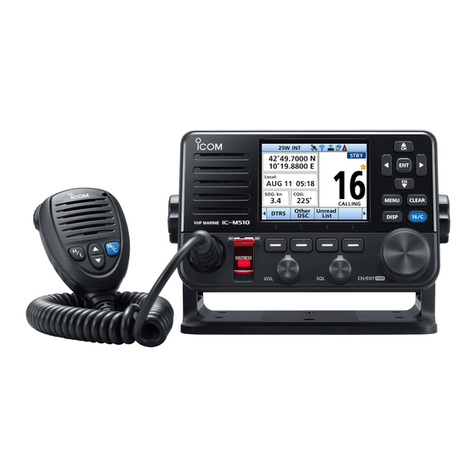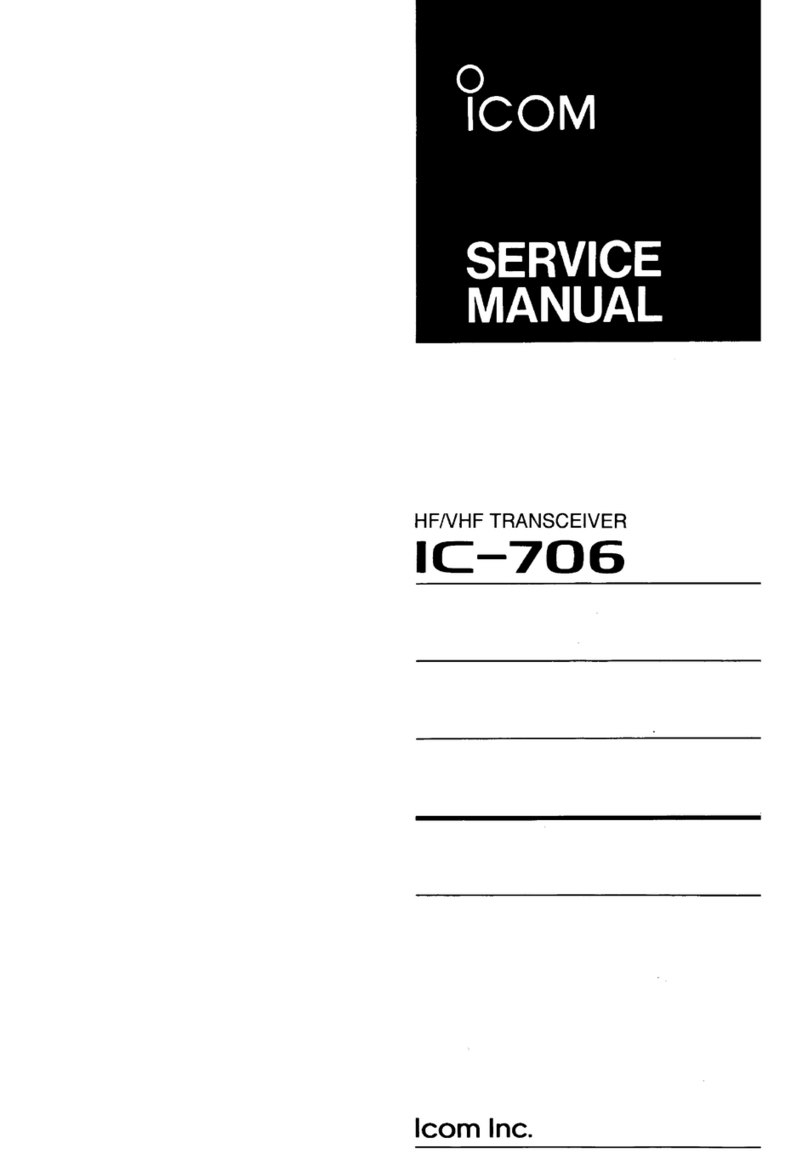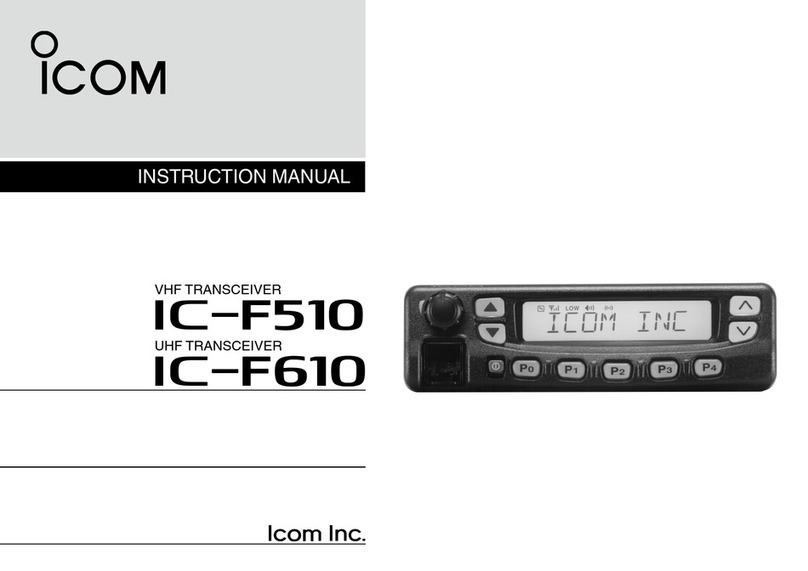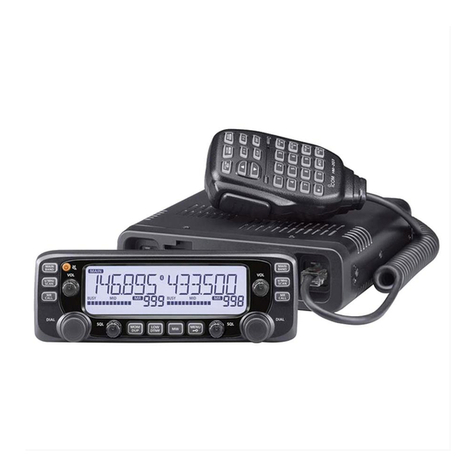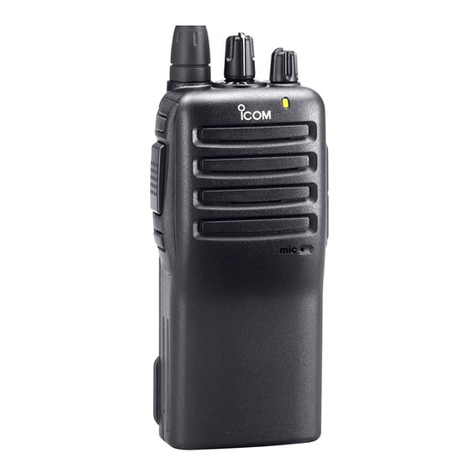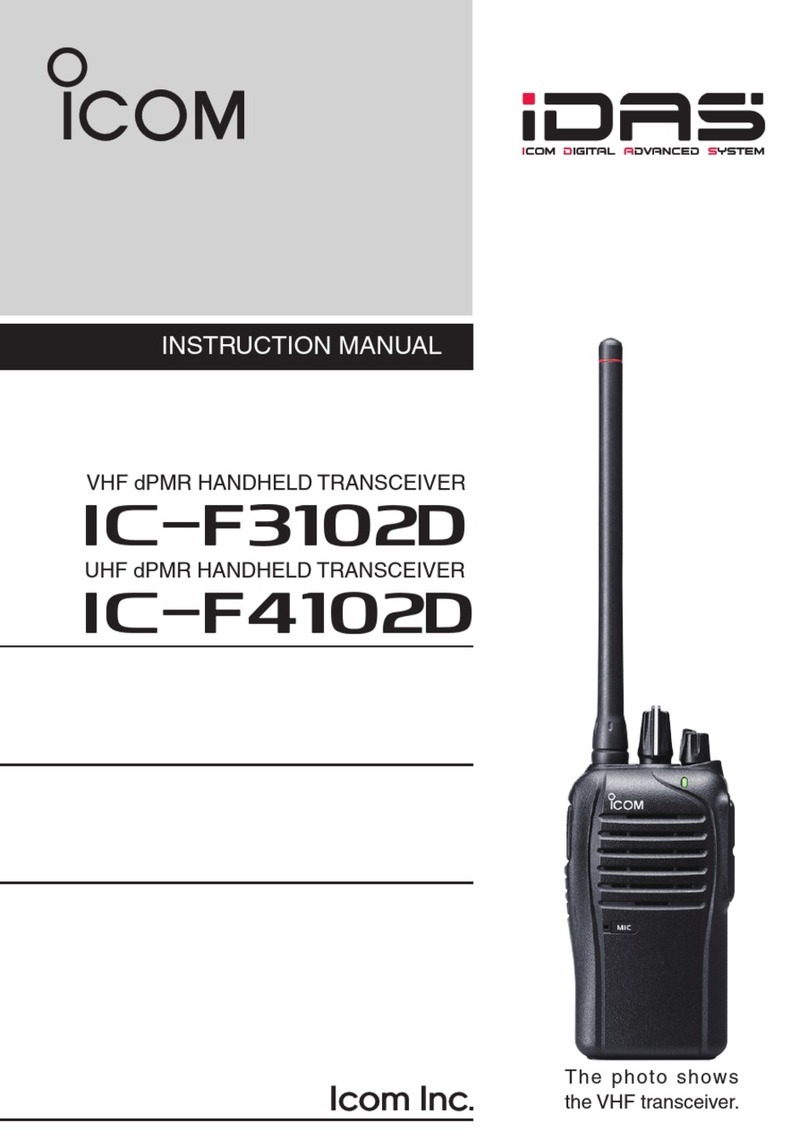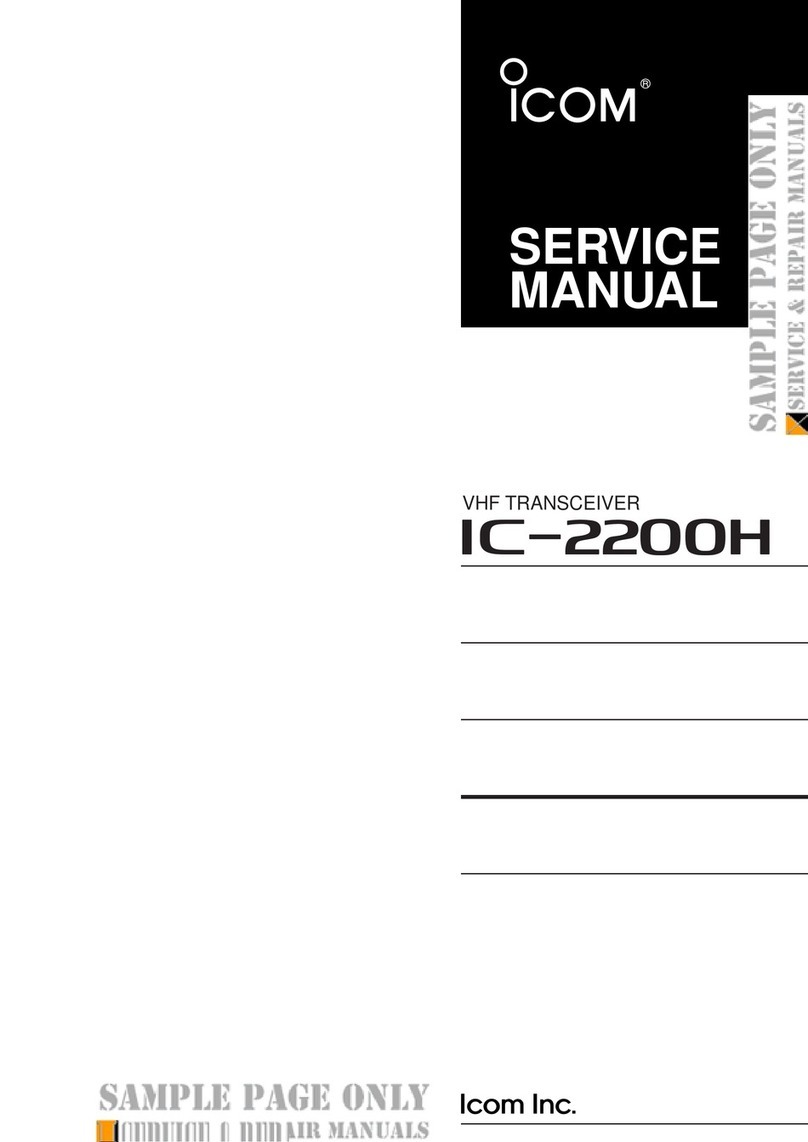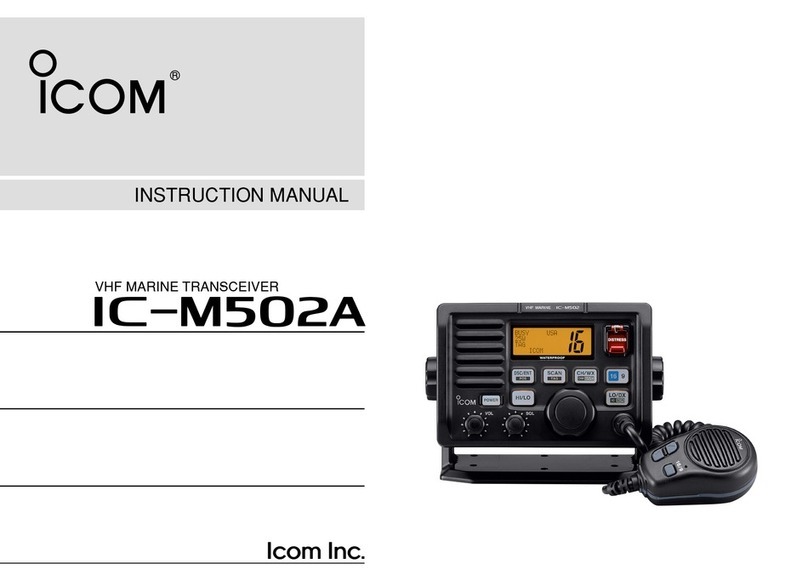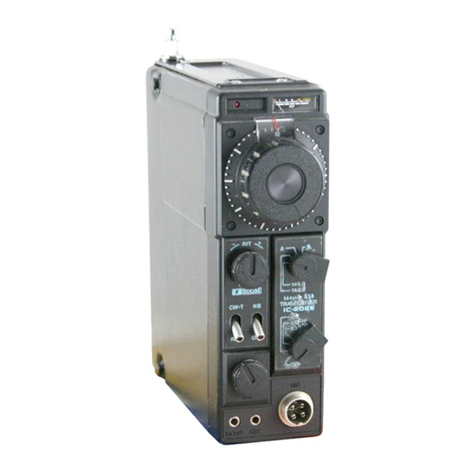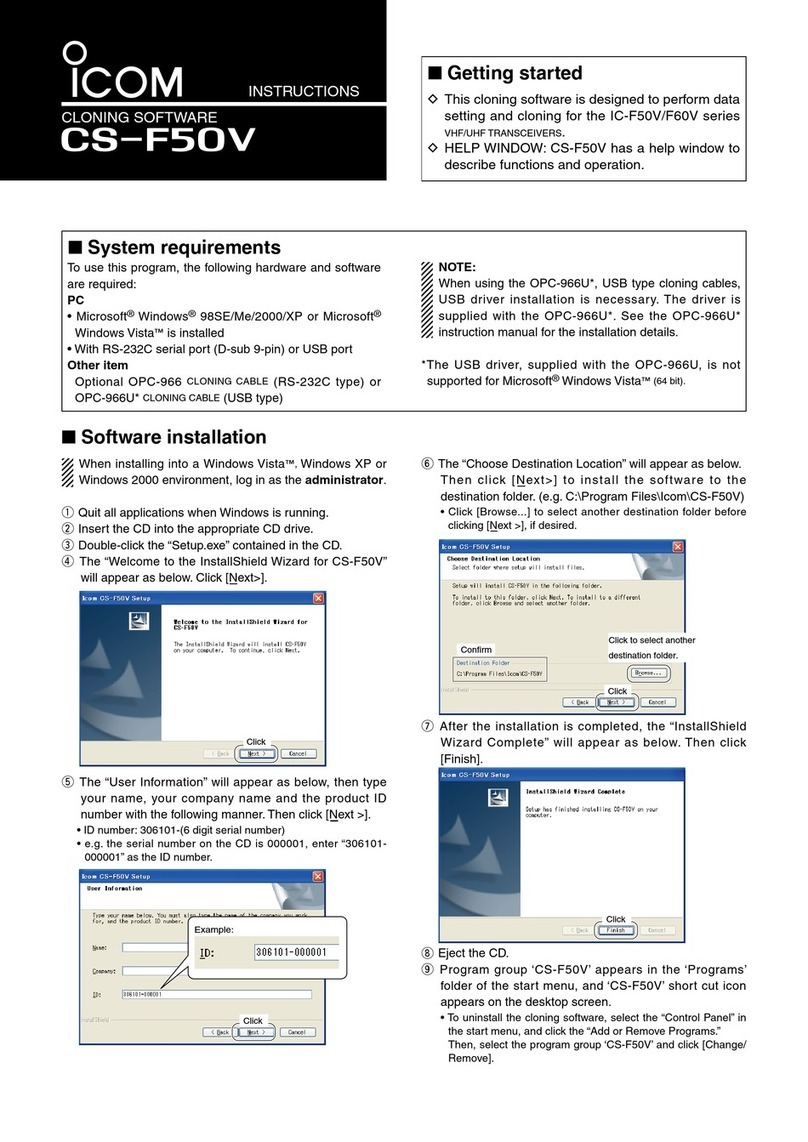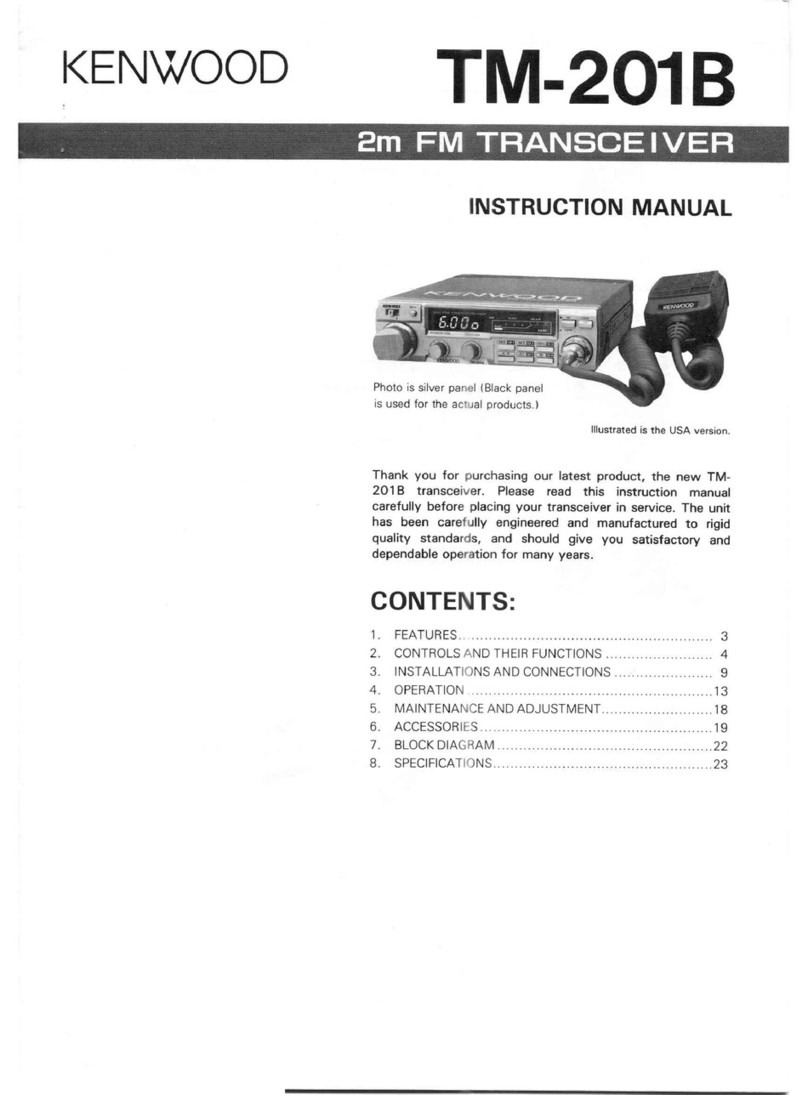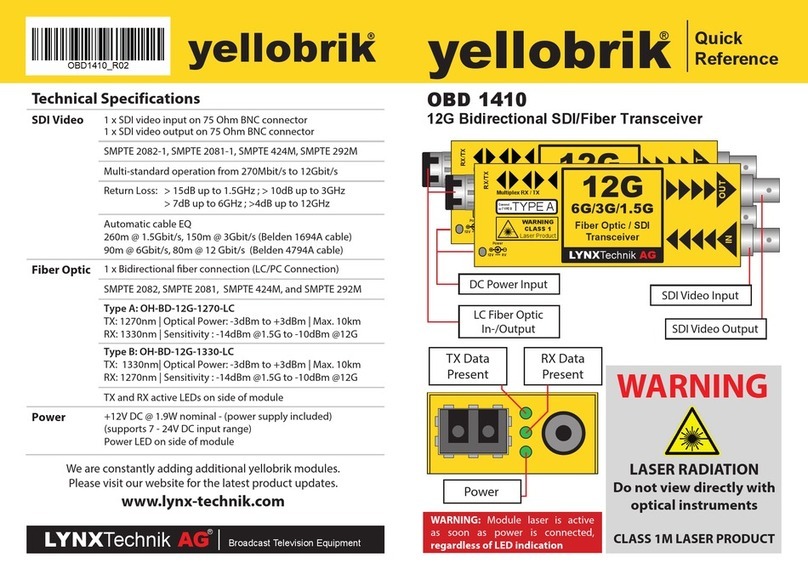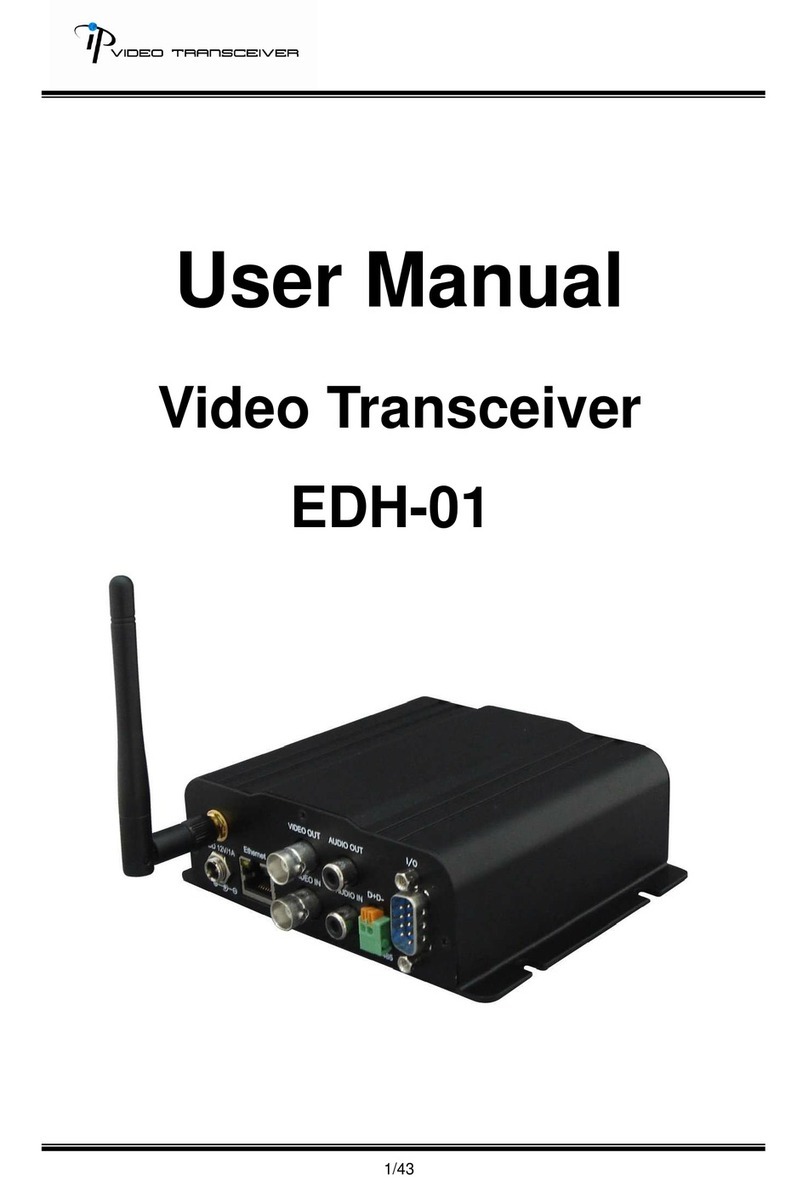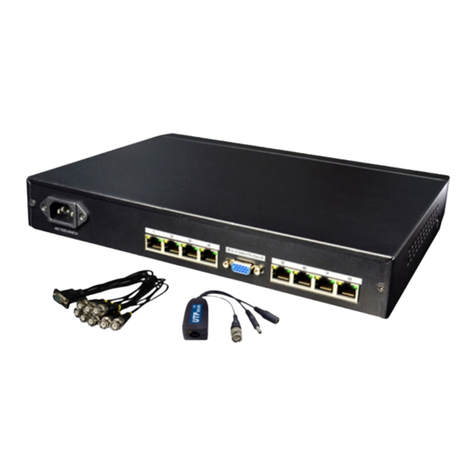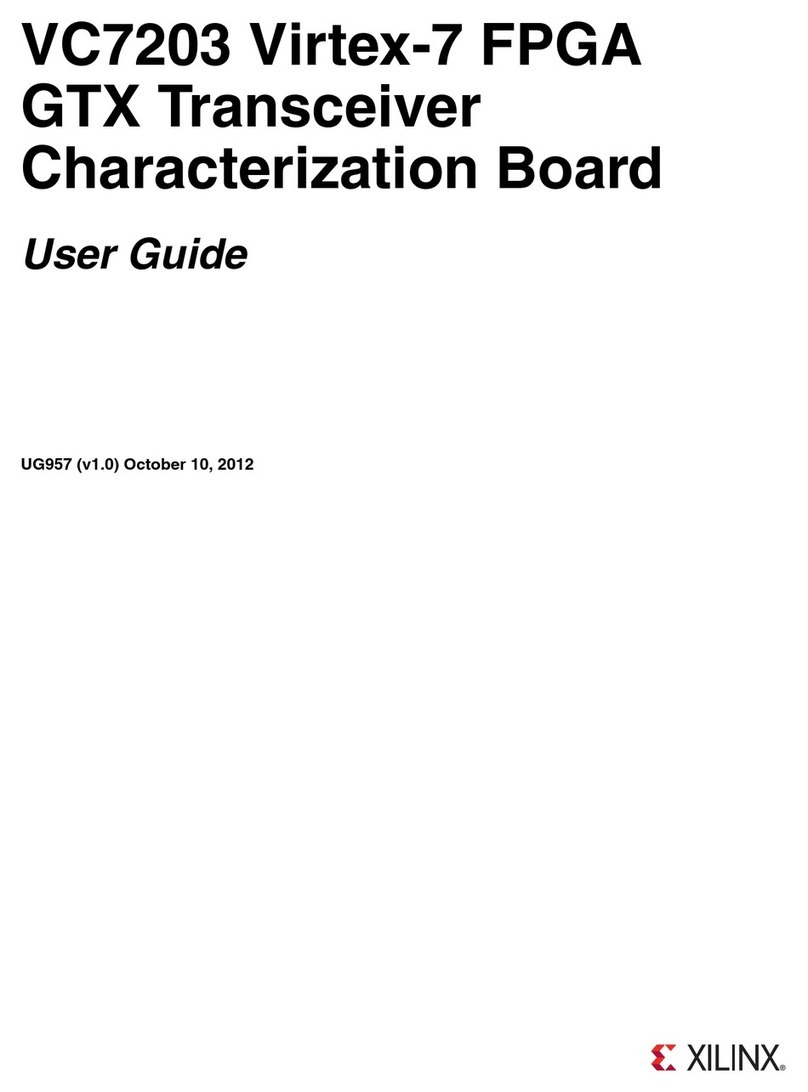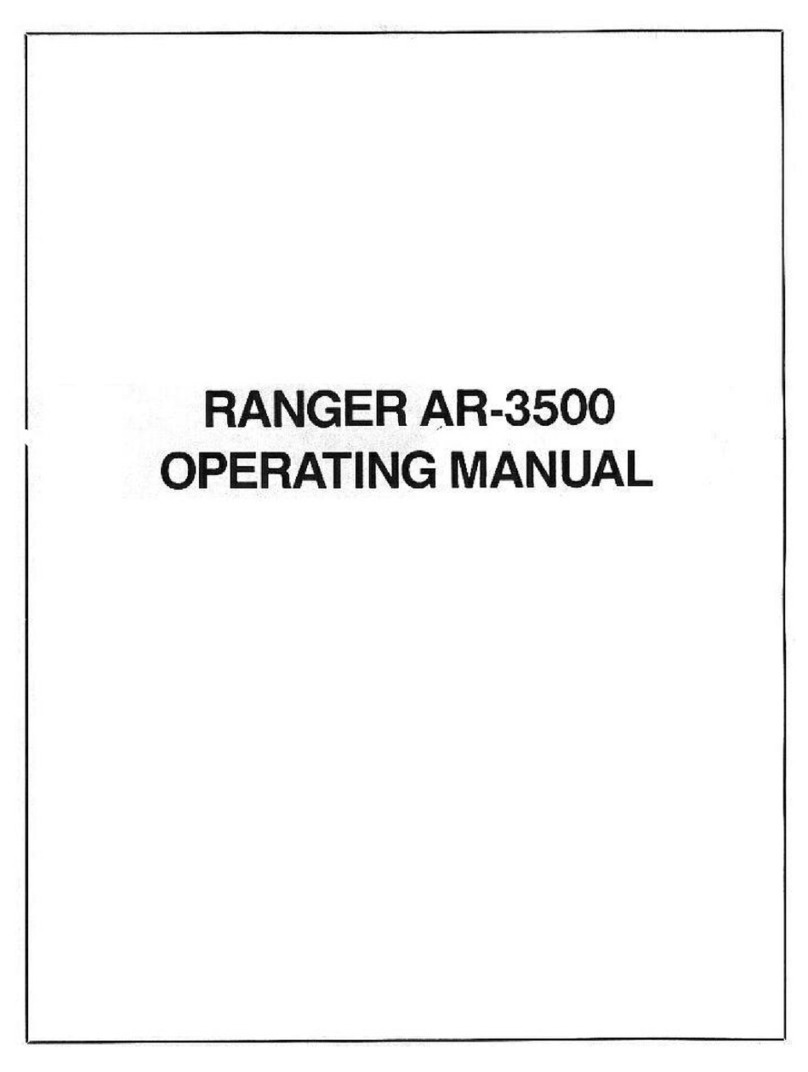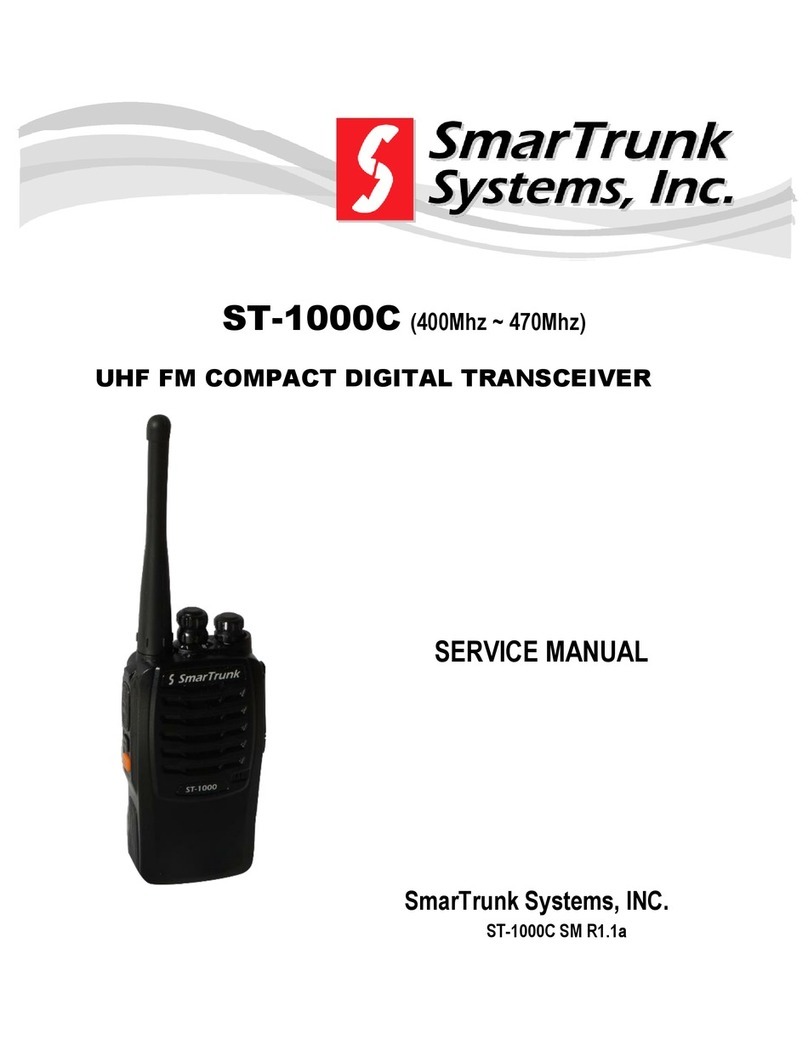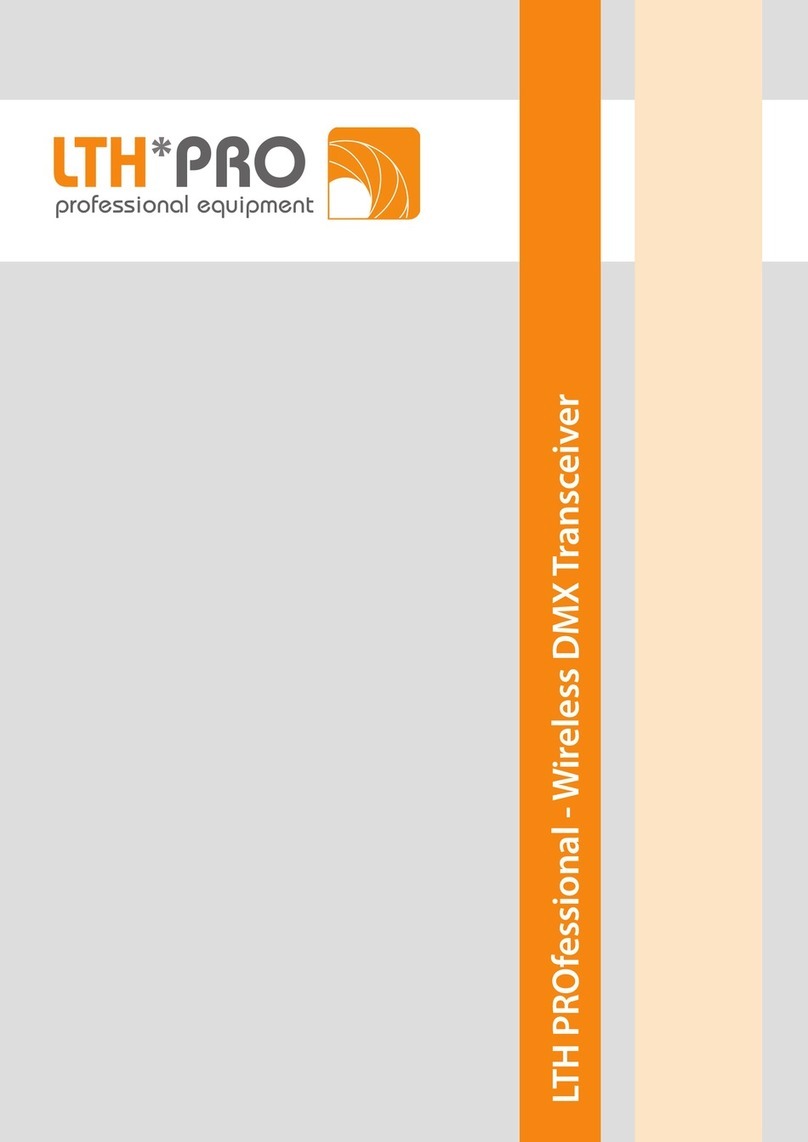Icom IC-T2H User manual

144
MHz
FM
TRANSCEIVER
IC-T2H
This
device
complies
with Part 15
of
the
FCC
rules
.
Operation
is
sub-
ject
to
the
following
two
conditions
:
(1)
This
device
may
not
cause
harmful
interference,
and
(2)
this
device
must
accept
any
interference
received,
including
interference
that
may
cause
undesired
operation
.
Icom
Inc
.

IMPORTANT
READ
ALL
INSTRUCTIONS
carefully
and
com-
pletely
before
using
the
transceiver
.
SAVE
THIS
INSTRUCTION
MANUAL-This
in-
struction
manual
contains
important operating
instructions
for
the
IC-T2H
.
EXPLICIT
DEFINITIONS
The
explicit
definitions
below
apply
to
this
instruction
manual
.
CAUTIONS
,&WARNING!
NEVER
hold
the
transceiver
so
that
the
antenna
is
very
close
to,
or
touching
exposed
parts
of
the
body,
especially
the face
or
eyes, while
transmitting
.
The
transceiver
will
perform
best
if
the
microphone
is
5
to
10
cm
(2
to
4
in)
away
from
the
lips
and
the
transceiver
is
vertical
.
,&WARNING!
NEVER
operate
the
transceiver
with
a
headset
or
other audio
accessories
at
high
volume
levels
.
Hearing
experts
advise
against
continuous
high
volume
op-
eration
.
If
you
experience
a
ringing
in
your
ears,
reduce
the
volume
or
discontinue
use
.
NEVER
connect
the
transceiver
to
an
AC
outlet
or to
a
power
source
of
more
than
16
V
DC
.
Such
a
connection
will
damage
the
transceiver
.
NEVER
connect
the
transceiver
to
a
power
source
that
is
DC
fused
at
more
than
5
A
.
Accidental
reverse
connection
will
be
protected
by
this
fuse,
higher fuse
values
will
not
give
any
protection
against
such
accidents
and
the
transceiver
will
be
ruined
.
NEVER
attempt
to
charge
alkaline
or
dry
cell
batteries
.
Be-
ware
that
external
DC
power
connections
will
charge
batteries
inside
the
battery
case
.
This
will
damage
not
only
the
battery
case
but
also
the
transceiver
.
DO
NOT
push
th
mit
.
Place
unit
in
asecu
dren
.
DO
NOT
operate
cal
blasting
caps
or
AVOID
using
or
K
In
areas
with
temp
+60°C
(+140°F)
.
The
use
of
non-Ic
transceiver
perform
Even
when
the
trar
flows
in
the
circuit
:
the
transceiver
wh
the
battery
pack
of
hausted
.
For
USA
only
.
Caution
:
Changes
pressly
approved
operate
this
trans(
WORD
DEFINITION
WARNING
Personal
injury,
fire
hazard
or
electric
shock
may
occur
.
CAUTION
Equipment
damage
may
occur
.
If
disregarded,
inconvenience
only
.
No
risk
NOTE
of
personal
injury,
fire
or
electric
shock
.

er
so
that
the
parts
of
the
>mitting
.
The
is
5
to
10
cm
r
is
vertical
.
;ceiver
with
a
plume
levels
.
i
volume
op
reduce
the
)utlet
or
to
a
)nnection
will
source
that
is
cnnection
will
I
not
give
any
ceiver
will
be
batteries
.
Be-
arge
batteries
ly
the
battery
DONOT
push
the
PTT
when
not
actually
desiring
to
trans-
mit
.
Place
unit
in
a secure
place
to
avoid
inadvertent
use
by
chil-
dren
.
DO NOT
operate
the
transceiver
near
unshielded
electri-
cal
blasting
caps
or
in
an
explosive
atmosphere
.
AVOID
using
or
placing
the
transceiver
in
direct
sunlight
or
in
areas
with
temperatures
below
-10°C
(+14°F)
or
above
+60°C
(+140°F)
.
The
use
of
non-Icom
battery
packs/chargers
may
impair
transceiver
performance
and
invalidate
the
warranty
.
Even
when
the
transceiver
power
is
OFF,
a
slight
current
still
flows
in
the
circuits
.
Remove
the
battery
pack
or
case
from
the
transceiver
when
not
using
it
for
a
long
time
.
Otherwise,
the
battery
pack
or
installed
Ni-Cd
batteries
will
become
ex-
hausted
.
For
USA
only
.
Caution
:
Changes
or
modifications
to
this
transceiver,
not
ex-
pressly
approved
by Icom
Inc
.,
could
void
your
authority
to
operate
this
transceiver
under
FCC
regulations
.
SUPPLIED
ACCESSORIES
Accessories
included
with
the
transceiver
:
O
Antenna
.....................................
1
OO
Belt
clip
.....................................
1
Os
Battery
case
(BP-194)
with
8 Ni-Cd
(AA)
batteries*
installed
...............
1
®
Wall
charger*
.................................
1
*Not
supplied
with
some
versions
.

TABLE
OF
CONTENTS
IMPORTANT
. .
.
............
...
.
.
.............
.
.
. .
.
. .
............
. .
.............
. .
.
.
............
.
..............
.
ii
EXPLICIT
DEFINITIONS
. .
. .
.
............
.....
...........
.
. .
...
. .
.
.........
....
............
...
..........
ii
CAUTIONS
.
....
...............
.
.
.
.
. .
............
. .
.
.
. .
.
.............
.....
.........
....
.
.
......... .
...
.
. .
.......
ii
SUPPLIED
ACCESSORIES
....
. .
.
.
.
.
..............
.....
............
...
..........
......
..........
.
.
...
iii
"
General
..........
....
.................
.
............
.....
...........
.
. .
...
. .
.
............
.
. .
.
.
. .
.......
.
19
"
Programming
a
memory
channel
.....
.
. .
. .
.
.
..............
....
............
.
. .
....
.
.
.....
.
19
"
Programming
the
call
channel
............
....
. .
.
............
. .
.
.
...............
......
.....
20
"
Memory
editing
. .
.
.
...
.............
.
.
.
. .
.
............
....
...............
...
. .
.
............
....
.....
21
O
Antenna
Connect
the
sup
nector
and
rotate
CAUTION
damage
the
t
TABLE
OF
CONTENTS
....
.
. .
.
.
.
.............
.....
.............
.
..............
....
............
...
......
IV
7
DTMF
MEMORY
......
.
. . .
.
............
....
.............
.
..................
.
.
...
...............
22-23
1
ACCESSORY
ATTACHMENT
.
.............
..
.................
..
..........
.
.
.
.
..
..............
.
.1
"
Programming
a
DTMF
code
...
. .
.
.
...........
.
. .
....
. .
.
............
. .
. . .
.
............
....
. .
22
2-7
"
Transmitting
a
DTMF
code
.....
.
. .
...
.
. .
..........
......
............
.
. . .
. .
.
.
..........
. .
.
. .
.
22
2
PANEL
DESCRIPTION
......
.
. .
..
.................
..
.............
..
.
.
...........
...
............
"
DTMF
transmission
speed
..........
.
. .
. .
..........
.
.
....
...............
.....
.............
...
23
"
Switches,
controls,
keys
and
connectors
. .
..........
. .
.
. .
.
.
.........
. .
.
...
........
.
2
"
Customizable keys
...............
....
.
.
..........
. .
.
.. .
. .
.
.........
....
............
.
.
.
............
.
58
SCAN
OPERATION
........
.
. .
.
.............
..
..............
.
. . .
.
. .
.
..........
.
. .
.
.
.
. .
.
......
24-25
"
Custom
key
assignment
......
......
.............
.
.
.
.
. .
...........
. .
.
. .
...........
.
..
.
..........
5
"
Scan
types
.. .
. .
.
. .
...........
.....
................
. .
............
......
...............
....
...........
.
24
"
Function
display
.
.
. . .
. .
...............
. .
.
.
. .
.
............
.
.
..
...........
....
............
...
..........
6
"
Programmed
scan
........
. .
.
.
. .
.
............
...
.
.
...........
.
.
. .
.
.
. .
.
............
. .
.
.
..........
.
25
3
BATTERY
PACKS
....
..
.
..
...............
.
.
.
.
.............
.
. .
.
............................. .
.
...
8-10
"
Memory
(skip)
scan
......
.
. .
....
.
.
..........
.
. .
. .
.............
.
. .
.
.
. .
............
.
. .
...
. .
.
......
25
"
Battery
pack
charging
.
.
. .
............
.....
.
.
............
...
.
. .
.........
....
. .
.
.........
...
. .
.
....
89
SUBAUDIBLE
TONE
OPERATION
.......
.
.
.
. .
.
.............
..
.
.
...............
.
.
...
26-27
"
Charging
precautions
.
....
............
.
. .
....
.
. .
..........
.
.
...
..........
..... .
..........
.
.
...
....
8
"
Tone
squelch
......
.
.
...
............
. .
.
.
. .
.
...........
....
............
.
. .
....
. .
.
............
. .
...... .
26
"
About
battery
packs
....
. .
.
.
.
.
............
.
.
.....
............
. .
.............
....
. .
.
.........
. .
.....
8
"
Tone
scan
. .
.
.........
.
. . . .
.
............
....
............
. .
.
.
.
.
..............
.....
...............
...
...
27
"
Charging
connections
.
.
. .
...
.
. .
............
....
. .
.
.............
. .
.........
.
. .
.
.
. .
.............
. .
.
9
"
Pocket
beep
operation
.
..........
.....
.
.
.........
.
. .
...
..
.
............
....
. .
.
............
...
.. .
27
"
Installing
batteries
in
the
battery
case
....
............
...
.
.
...........
.....
..........
. .
10
10
OTHER
FUNCTIONS
.
.
. .
..
...............
.
. .
.
...........
.
.
...
................
..
. .
.
..........
28-32
4
BASIC
OPERATION
..................
...
...............
.
..
..............
..
............
.
..
...
.11-14
"
Initial
set
mode
...........
.
.
.
. .
.
...........
.....
............
. .
.
.
.
.
.............
......
. .
.
........ .
. .
.
28
"
Power
ON
.
.
.
.
. .
.
............
. .
.
....
. .
.
..........
.
.
...
............
. .
.
.
. .
.
.........
...
............
. .
.
.
. .
11
"
Resetting the
CPU
........
...
............
.
. .
.
.
. .
............
...
. .
.
............
.
. .
.
.
. .
.........
. .
.
30
"
Setting
a
frequency
....
.
. .
.
.
. .
.
. .
............
. .
. . .
.
............
.
.
. .
.........
.
. . .
. .
............
...
11
"
Key
customize
mode
....
. .
.
.
...............
...
.
.
...........
.
.
. .
................
.....
........
.
.
.
31
"
Dial
select
function
......
............
.
.
.
.
. .
............
. .
.
....
.........
.
. .
.
...........
. .
.
. .
.
.
.....
12
"
Guide
function
.
.
. .
.
.
............
...
. .
.
..........
.
.
....
............
.
. . .
. .
............
. .
.
....
. .
.
.....
.
31
"
Receive
and
transmit
.
.
.
. .
............
. .
.
. .
.............
.
.
. .
.
. .
.........
...
. .
.
.........
.
.
. .
.
. .
. .
12
11
ANI
OPERATION
.
..
.
..
.............
..
................................
..
.
..
................
.
.
.
.33-35
"
Selecting
a
memory
channel
.... .
.
. .
...
. .
.
...........
.....
..........
.....
...........
.....
. .
13
MAN
I
mode
ON
.....
....
............
.
. . . .
.
............
....
............
.
. .
.
.
.
. .
.
............
....
......
33
"
Lock
function
.
.
............
. .
.
....
. .
.
............
...
............
. .
.
.
. .
.
.........
. .
.............
. .
.
.
.
.
13
"
General
.
. . . .
.
.........
.
. .
.
.
. .
............
...
.
.
..........
..
.
. .
.
.
...............
...
............
.
. .
.
.
. .
...
33
"
Notes
for
set
mode
.......
.
.
.....
............
. .
.
.
.
.
............
....
............
...
. .
.
.........
...
14
"
Operation
...
.
.
...........
.....
..........
.
. .
...
. .
.
.........
.
.
. .
.
. .
............
. .
.
.
.
.
..
.
.........
....
...
34
"
Setting
tuning
steps
.........
. .
.
.
. .
.
............
...
.
. .
..........
.....
..........
. .
.
. .
...........
. .
14
12
CLONING
......
...
.............
.
. . ...............
..
..............
.
. .
.
...............
.
.
...
............
.
...
36
5
REPEATER
OPERATION
...... .
..
. .
.
.............
..
.............................
.
.
.
......
15-18
15
13
TROUBLESHOOTING
.....
..
.
.
...........
.
. .
.
.
.
..............
.
.
..
.............
.
. . .
..
..........
..
.
37
"
General
.
............
. .
.
.
.
.
. .
.
..........
.
.
....
. .
.
............
...
.
.
......... .
....
...........
....
.
.
.......
38
"
Subaudible tones
.
...
.
. .
............
. .
.
.
.
. .
............
......
.........
.....
...........
. .
.
. .
.......
16 14
SPECIFICATIONS
.
..............
..
..............
.
. .
..
.............
.
.................
.
. .
..
...........
"
Offset
frequency
......
. .
. . .
.
............
......
.............
...
. .
.
......
.
. .
....
. .
.
.........
...
. .
.
...
16 15
OPTIONS
............
.
.
.
. .
.
............
.
..
.............
..
.................
..
.
..
...............
.
........ .
.
39
"
Auto
repeater
function
. .
.
.
..........
. .
.
....
. .
.
...........
....
.........
.
.
.....
...........
....
...
17 16
MODE
ARRANGEMkNT
..........................
..
............... .
.
..................
..
.
40-41
6
MEMORY/CALL
PROGRAMMING
....
.
..
.............
.
. .
.
............
.
.
.
.
...........
19-21 42-43
17
CE
.
..............
.
.............
...
. .
.
..........
..
.
..
..........
.
. .
...
...............
.
..
.
.
..............
.

.
........
.
. .....
.
. .
...
..........
.1
s
.
......
...
. ..... .
. .
. .
.
.
. .
.
.
..... .
19
.
.
.
.
......
.
.,
. .
............
.
.
. .
.
21
. .
.
.........
....
...........
22-23
...
....
....
.. . .
...
. .
............
22
...
....
....
.,
.
.
...
. .
...
. .
.
......
22
......
.
...
.,
.. .
.........
.
.. .
. .
...
23
........
.
. .
...
.............
24-25
.
......
...
.
.
.
..................
24
. .
.....
.
.
. .
. .
.
. .
...
............
25
. .
.......
. .
.
.,
.
...
..
.......
......
25
.
. .
.
........................
26-27
.
...
...
.....
.
.
..............
.
. .
.
26
.
...
...
.......
..
....
.
............
.
27
.
......
.
....
.,
. .
.
.
.
.
.
...
..........
27
.
.......
..
. . .
..
...
.
.... .
..
.
.
28-32
. .
......
.
.
.
.
...
.............
.
.
. .
. .
28
...
.......
.
.
.,
.
..................
.
30
...
.
.......
....
....
. .
.
.
...........
31
...
....
....
...
.
...
. .
. .
.
.
.
. .
.......
31
......
.
....
.
................
33-35
......
. .
.
.
.
.
.................
.
. .
. .
33
........
. .
.
.
. .
.
....
.
. .
.
...........
33
...
......
. .
...
.
. . .
.
.
...
...........
34
..........
.
. . . .
.
.......
..
.
...
. .
.
. .
36
.
.............
.
...............
.
. .
..
37
.
...
.
........
. .
...
..
. .
.
............
38
.
......
...
. . .
.
. .
..
......
..
.
..
......
39
.
...........
.
. . ..............
40-41
.
..
.........
.
. . . .
..
......... .
42-43
O
Antenna
Connect
the
supplied
flexible
antenna
to
the
antenna
con-
nector
and
rotate
the
antenna
clockwise
.
V
CAUTION
:
Transmitting
without
an
antenna
may
damage
the
transceiver
.
ACCESSORY
ATTACHMENT
O
Belt
clip
To
attach
:
Slide
the
belt clip
into
the
plastic
loop
on
the
back
of
the
battery
case/pack
.
To
remove
:
Push
the top
of
the
belt
clip
towards
the
transceiver
and
at
the
same
time,
push
it
downwards
and
free
of
the
plastic
loop
.

PANEL
DESCRIPTION
"
Switches,
controls,
keys
and
connectors
©[PWR/VOL]
Q[PTT]
041111
-
1
~
.
I
04
15
II_IIIIIIIIII_III
"
--
D
lo
P
°
,
o
aA
°
~ApPO~~P~}O
O
P
04
PiADApP1
4
10
11
p[UP/DOWN]
11111111
Q[MONITOR]
111111
,
InII
©[SP/MIC]
[GUIDE]
m[DIGIT
KEYS]
m[MHz
KEY]
[ANTENNA]
~b[CHARGE]
O[TX]
-fl[DIAL
SELECT]
[CUSTOMIZABLE
KEYS]
PTT
SWITCH
Push
and
holc
®
POWERNOL
w+
Rotate
to
tL
Rotate
cloc
wise
to
dec
A
EXTERNAL
;
[SP/MIC]
Connect
an
of
sired
.
The
into
tion
when
eitl-
O
External
c
Bw
NOTE
:
Whe
speaker-micr
o
~
Remote
ISPI
e
-
vn
O
ANTENNA
C
Connects
the
©
EXTERNAL
Connect
a
1,
cables,
CP-1

Q
PTT
SWITCH
[PTT]
(p
.
12)
Push
and
hold
to
transmit
;
release
to
receive
.
©
POWER/VOLUME
CONTROL
[PWRNOL]
r
.
Rotate
to turn
power
on
and
off
.
k.
Rotate
clockwise
to
increase
volumeand
counterclock-
wise
to
decrease
volume
.
©EXTERNAL
SPEAKER
AND
MICROPHONE
JACKS
[SP/MIC]
Connect
an
optional
speaker-microphone
or
headset,
if
de-
sired
.
The
internal
microphone
and
speaker
will
not
func-
tion
when
either
is
connected
.
(See
p
.
37
for
options
.)
O
External
connection
ow
NOTE
:
When
connecting
or
disconnecting
an
external
speaker-microphone,
first
turn
off
power
to
the
transceiver
.
60---
Remot
k
~
[SP[
PTT
O
ANTENNA
CONNECTOR
(p
.
1)
Connects
the
supplied
antenna
.
00
Audio
out
(e
n)
-0o
This
connection
does
not
apply
when a
conden-
sor
microphone
is
connected
.
©
EXTERNAL
DC
POWER
JACK
[CHARGE]
Connect
a
13
.5
to
16
V
DC
power
source
using
optional
cables,
CP-12L
or
OPC-254L,
to
charge
the
batteries,
or
connect
the
BC-1
10A/DN
wall
charger
for
charging
.
V
CAUTION
:
This
connection
is
for
charging
only
.
Power
to
the
transceiver
must
be
turned
off
during
charging
.
O
TX
INDICATOR
[TX]
(p
.
12)
Lights
red
while
transmitting
.
O
UP/DOWN
KEY
[
"
]/[V]
1-*
In
VFO
mode,
increment
or
decrement
the
dis-
played
frequency according
to
the
set
tuning
steps
.
(p
.
11)
~
"
In
memory
mode,
increment
or
decrement
the
selected
memory
channel
.
(p
.
13)
~
"
In
initial
set
mode,
select
item conditions
.
(p
.
28)
O
PANEL
DESCRIPTION
0
MONITOR
KEY
[
4(MONI)]
(p
.
13)
Push
and
hold
this
switch
to
force
the
squelch
open
;
release
to
close
it
again
.
k
.+
Push
twice
to
keep
the squelch
open
;
push
again
to
close
it
.
%*While
pushing
[PTT],
push
this
switch to
trans-
mit
a
1750
Hz
tone
signal
.
(Europe
version
only)
ii*
When
a
digit
is
mistakenly
input,
push
[
]
and
input
from
the
beginning
.
O
DIAL
SELECT
KEY
[
4
]
(p
.
12)
Push
this
switch
one
or
more
times
to
select
the
dial
select
step
for
frequency
tuning
.

PANEL
DESCRIPTION
(D
SQUELCH
KEY
[SQL]'
Push
[SQL],
then
push
[A]/[V]
one
or
more
times
to
select
squelch
level
.
"AUto",
"Sql
1"
to
"Sql
8"
are
available
to
suit
personal
preferences
and
operating
conditions
.
(p
.
13)
SQL
(D
SCAN
START/STOP
KEY
[SC]'
Push
[SC] to
start
the
scan
.
(p
.
25)
-To
change
the
scan
direction,
push
[
"
]
or
[
"
] .
~+
Push
[SC]
again
to
stop
the
scan
.
(p
.
25)
sc
©
DUPLEX
KEY
[DUP]'
kl+
Pushonce
to
select
-
DUP
or
twice
to
select
DUP
DUP
mode
.
(p
.
15)
©
POWER
SELECT
KEY
[H/L]'
~+
Push
to
toggle
high
and
low
power
output
.
(p
.
12)
"
"LOW"
appears
when
low
power
is
selected
.
m
VFO/MEMORY
KEY
[A
V]'
Av
Push
to
toggle
VFO
mode
and
memory
mode
.
(p
.
11)
"
"m"
appears
when
memory
mode
is
selected
.
Push
for
1
sec
.
t
o
enter
"Set
mode"
.
(p
.
14)
+Transmits
an
"A" for
DTMF
operation
while
pushing
[PTT]
.
©
MEMORY
WRITE
KEY
[B
M]'
e
nn
k+
Push
[B
M],
then
select
a
memory
channel
num-
ber
with
[A]/[V]
.
~1
"
Push
[B
M]
for
1
sec
.
t
o
program
the
information
into
the
memory
channel
.
(p
.
19)
r+
Transmits
a
"B"
for
DTMF
operation
while push-
ing
[PTT]
.
(D
TONE
SETTING
KEY
[c
T]"
cr
'+
Toggles
tone
squelch
operation
ON/OFF
.
"
"T",
"TSQL"
or
"TSQL"
appears
on
the
display
.
r
.
Transmits
a
"C"
for
DTMF
operation
while push-
ing
[PTT]
.
m
LOCK
KEY
[D
L]'
Toggles
the
lock
function
ON/OFF
.
(p
13)
Transmits
a
"D"
for
DTMF
operation
while
push-
ing
[PTT]
.
m
GUIDE
KEY
[#]
(p
.
31)
w+
Activates
the
guide
function
.
,
-*Transmits
an
"F" for
DTMF
operation
pushing
[PTT]
.
while
m
DIGIT
KEYS
Input
the
specified
digit
memory
channel
selection,
etc
.
,
.*Transmit
the
DTMF
code
of
the
specified
digit
while
pushing
[PTT]
.
during
frequency
input,
m
MHzKEY
[*]
(p
.
12)
~+
Used
as a
short
cut
for
inputting
frequencies
.
+Transmits
an
"E"
for
DTMF
operation
while
pushing
[PTT]
.
keys
can
I:
of
avail,
n
this
m
icon
.
e
the
follc
"a"
indic+
V"tes
theas
Guide
fun
The
guide
functi
quirky
and
eas
Once
a
key
fun
guide
function
i;

*Customizable
keys
[SOL],
[SC],
[DUP],
[H/L],
[A
V],
[e
M],
[c
T],
[D
L]
These
keys
can be assigned a
variety
of
functions
(see
p
.
32
for
a
list
of
available
functions)
.
NOTE
:
In
this
manual,
the
customized
keys are
represented
by
the
"W"
icon
.
Operations
which
require
a
customizable
key
observe
the
following
style-
Push
I*
(FUNCTION)]
where
"a"
indicates
the
key
is
customized
and"FUNCTION"
indicates
the
assigned
function
e
.g
.
TONE,
etc
.
O
Guide
function
(p
.
31)
The
guide
function
displays
the
function
of
keys
and
switches
quickly
and
easily
.
Once
a
key
function
has
been
changed
from
its
default,
the
guide
function
is
a
convenient
way
to
determine
its
function
.
PANEL
DESCRIPTION
"
Custom
key
assignment
Write
down
your
key
assignments
for
reference
.
5
gram
the
informati
p
.
19)
>peration
while
pu
ition
ON/OFF
.
rs
on
the
display
.
)peration
while
pus
~N/OFF
.
(p
13)
)peration
while
pus
1
.
MF
operation
wh
ring
frequency
inp
etc
.
of
the
specified
d]
itting
frequencies
.
MF
operation
wlt
Key
Default
Your
Assignment
[A]
UP
fixed
[
"
]
DOWN
fixed
K
MONI
fixed
[
4
]
DIAL
SELECT
faced
[SQL]
SQUELCH
[SC]
SCAN
[DUP]
DUPLEX
[H/L]
HI/LO
[0]-{9]
NUMERAL
INPUT
''
fixed
[A
V]
V/m
[e
M]
Smw
[c
Tj
TONE
[D
L]
LOCK
[#]
MHzKEY
fixed
[*]
GUIDE
KEY
fixed

G
PANEL
DESCRIPTION
"
Function
display
Tr0
-DUP
T
0
L15011
.ills---®
.;
Fir-1
:
1
X11
~1,
..
..
.
~
.
50
.:
--
o
~'
i~ll11'I
I'I
I'I
I
'I
I'I
,
"
__
"
_
!__
~25l
USY
"""
©
"""O"
.
-
i
-
SKIP
. .
.-
~
°
I
O
MEMORY
MODE
INDICATOR
(p
.
13)
Appears
while
in
memory
mode
.
MR
©
LOCK
INDICATOR
(p
.
13)
Appears
while
the
lock
function
is
activated
.
©
DUPLEX
INDICATOR
(p
.
15)
Appears
during
semi-duplex
operation
.
"
"-DUP"
appears
for
minus
duplex
;
°DUP"
appears
for
plus
du-
plex
.
O
TONE
INDICATORS
"T"
appears
when
the
subaudible
tone
encoder
(p
.
16)
is in
use
;
"T
SQL
(l0)
"
appears
during
pocket
beep
operation
(p
.
27)
and
"T
SQL"
appears
when
the
tone
squelch
func-
tion (p
.
26)
is
activated
.
©
ANI
INDICATOR
(p
.
33)
Appears
when
the
transceiver
is
set
to
ANI
(Automatic
Number
Identification)
operation
mode
.
O
LOW
BATTERY
INDICATOR
k-
"
Appears
when
the
battery
is
nearing
exhaustion
.
k-+
Appears
and
flashes
when
battery
replacement
is
nec-
essary
.
O
FREQUENCY
READOUT
~+
In
frequency
indication
mode,
indicates
the
operating
frequency
.
(p
.
11)
-The
smaller
"75,"
"50"
and
"25"
to
the
right
of
the
readout
in-
dicates
7
.5,
5
.0
and
2
.5
kHz,
respectively
.
~+
In
channel
indication
mode,
indicates
the
selected
chan-
nel
.
(p
.
11)
r+ln
set
mode
or
item,
condition,
04BUSY
AND
S/RF
r+"BUSY"
appea
squelch
is
opei
k*
The
S/RF
indi
while
receivinc
(2
segments
a
pear
for
high
®
LOW
POWER
If
Appears
when
Ic
m
SKIP
INDICATC
Appears
when
tl'
nel
.
m
MEMORY
CHA
Indicates
the
sf
such as
the
call

%Nl
(Automatic
iaustion
.
icement
i
s
nec-
s
the
opefating
of
the
readout
in-
selected
ch
an-
~+
In
set
mode
or
initial
set
mode,
indicates
the
selected
item,
condition,
etc
.
0
BUSY
AND
S/RF
INDICATORS
(p
.
12)
ww
"BUSY"
appears
when
receiving
a
signal
or
when
the
squelch
is
open
.
ww
The
S/RF
indicators
show
the
relative
signal
strength
while
receiving
and
the
output
power
when
transmitting
(2
segments
appear
for
low
power
and
all
segments
ap-
pear
for
high
power)
.
O
LOW
POWER
INDICATOR
(p
.
12)
Appears
when
low
output
power
is
set
.
m
SKIP
INDICATOR
(p
.
25)
Appears
when
the
selected
channel
is
set
as a
"skip"
chan-
nel
.
m
MEMORY
CHANNEL
INDICATOR
(p
.
13)
Indicates
the
selected
memory
channel
and
other items
such
as
the
call
channel
.
PANELDESCRIPTION

BATTERY
PACKS
"
Battery
pack
charging
The
supplied
BP-194
BATTERY
CASE
includes
rechargeable
Ni-Cd
batteries*
and
can
be
charged
approx
.
300
times
.
Charge
the
batteries
before
first
operating the
transceiver
or
when
they
become
exhausted
.
If
you
want
to
be
able
to
charge
the
batteries
more
than
300
times,
the
following points
should
be observed
:
1
.
Avoid
overcharging
.
The
charging
period
should
be
less
than
48 hours
.
2
.
Use
the
batteries
until
they
become
completely
exhausted
under normal
conditions
.
We
recommend
battery
charging
just
after
transmitting
becomes
impossible
.
*Not
supplied
with
some
versions
.
"
Charging
precautions
NEVER
attempt
to
charge
dry
cell/alkaline
batteries
.
This
will
cause
internal
liquid
leakage
and
damage
the
battery
case
and
transceiver
.
NEVER
connect two
or
more
chargers
at
the
same
time
.
Charging
may
not
occur
under
temperatures
of
10°C
(50°F)
or
over
temperatures
of
40°C
(104°F)
.
"
About
battery
packs
O
Operating
period
Depending
on
installed
battery
pack
(batteries),
the
operating
period
of
the
transceiver
varies
.
Refer
to
p
.
39
for
operating
period
details
.
O
Battery
life
If
your
batteries
seem
to
have
no
capacity
even
after
being
fully
charged,
completely
discharge
them by
leaving
the
power
ON
overnight
.
Then
fully
charge
them
again
.
If
the
batteries
still
do
not
retain
a
charge
(or
very
little),
new
batteries
must
be
purchased
.
Recycling
information
(USA
only)
The
product
that
you purchased
contains
a
rechargeable
battery
.
The
battery
is
recyclable
.
At
the
end
of
its
useful
life,
under
various
state
and
local
laws,
it
may
be
illegal
to
dispose
of
this
battery
into
the
municipal
waste stream
.
Call
1-800-8-BATTERY
for
battery
recycling
options
in
your area
or
contact
your
dealer
.

s),
the
operating
39
for
operating
by
leaving
the
again
.
r
very
little),
new
I
sed
contains
a
is
recyclable
.
At
~arious
state
and
is
battery
into
the
TERY
for
battery
ur
dealer
.
"
Charging
connections
O
Regular
charging
O
Rapid
charging
with
the
BC-119
When
charging
a
battery
case
(pack)
attached
to
the
trans-
The
optional
BC-119
provides
rapid
charging
of
optional
ceiver
the
power
must
be
OFF
.
Ni-Cd
battery
packs
(power
to
the
transceiver
must
be
OFF
Transceiver
with
during
charging)
.
The
following
are
additionally
required
:
attached
battery
case
"
AD-81
even
after
being
(pack)
M
CP-12L
-An
AC
adapter
(maybe
supplied
Charging
periods
:
15
hours
(w/BP-195)
20
hours
(w/BP-196)
To
OPC-254L
[CHARGE]
(optional)
(optional)
with
the
BC-119
depending
'Not
supplied
with
some
versions
.
on
version)
.
Charging
periods
:
1
hour
(w/BP-195)
1
.5
hours
(w/BP-196)
BATTERY
PACKS

BATTERY
PACKS
"
Installing
batteries
in
the
battery
case
When
using
a
battery
case
attached
to
the
transceiver,
install
8
AA(R6)
size
Ni-Cd
or
alkaline
batteries
as
illustrated
below
.
O
Remove
the
bat-
tery
case from
the
transceiver
.
O
Install
8 x
R6(AA)
size
Ni-Cd
or
alka-
line
batteries
.
"
Be
sure
to
observe
the
correct
polarity
.
"
NEVER
connect
DC
power
to
the
transceiver
when
in-
stalling
dry
cell
or
alkaline
batteries
.
Such
a
connection
will
damage
the
transceiver
.
"
Be
careful
of
battery
overcharging
.
When
operating
via
ex-
ternal
DC
power,
installed
batteries
are
simultaneously
charged
.
"
Keep
battery
contacts
clean
.
It's
a
good
idea
to
clean
bat-
tery
terminals
once
a
week
.
"
Powei
Rotate
[PWRA
to
turn
power
C
O
Toggling
indication
Channel
indica
mode
only
pre
displayed
and
i
[
4
],
[H/L]
and
To
toggle
betty
While pushing
Frequency
indics

"
Power
ON
Rotate
[PWR/VOL]
clockwise
to
turn
power
ON
.
j-
1
I
1111
11
1
1
11
1,1
1 1
11111111111111111
ICOM
u
0
o
0
00000
00o0000
000000000
0000000
000000
.000
0000000
000000000
0
0000
.00000
\ooo0i
O
Toggling
frequency/channel
ATP
OWER
ON
indication
mode
Channel
indication
mode
is
used
to
simplify
operation
.
In
this
mode
only
pre-programmed
memory
channel
numbers
are
displayed
and
functions are
limited
([PWRNOL],
[n L],
[PTT],
[
4
],
[H/L]
and
[SC]
are
functional)
.
To toggle
between
the
indication
modes
:
While
pushing
[V]
+
[0],
rotate
[PWRNOL]
to
turn
power
ON
.
1
1_1_ 11
1
1
11
11
1
Frequency
indication
Channel
indication
BASIC
OPERATION
4
"
Setting
a
frequency
from
the
100
kHz
digit,
if
desired
.
-When
a
digit is
mistakenly
input,
co
O
(O
push
[
14
]
and
input
from
the
begin-
ning
.
"
"2"
and
"T
are
acceptable
for
the
1
kHz
digits
(depending
on
the
10
kHz
digit)
.
11
11
1
ill
1
1
i
1
1
_1
.
_11_1
O
Using
the
[
"
]/[V]
keys
Each
push
increments/decrements
the
frequency
according
to
the selected tuning step (see
right),
except
when
the
100
kHz
or
1
MHz
dial
select
step
is
selected (see
following
page)
.
When
a
dial
select
step
is
selected,
each
push
incre-
ments/decrements
the
frequency
either
100
kHz
or
1
MHz
.
O
Via the
keypad
O
Push
[a
V]
to
select
VFO
mode,
if
necessary
.
02
Push
6
digit
keys,
starting
from
ice)
a
1
~©1
the
100
MHz
digit,
to
input
a
fre-
quency
.
11
I1
1
1
1
.
"
Push
the
[*]
key
first
to
start
input

BASIC
OPERATION
"
Dial
select
function
Use
the
dial
select
function
to
adjust
the
tuning
behaviour
or
the
[
"
]/[V]
keys-use
1
MHz
tuning
when
you
want
to
change
the
frequency
in
large
increments
;
use
the
selected
tuning
step
when
you
want
to
change
the
frequency
in
smaller
increments
.
O
Push
[4]
one
or
more
times
to
select
the
desired
[A]/[
"
]
key
tuning
increment
.
"
1
MHz
tuning,
100
kHz
tuning
or
regular
tuning
steps
can be
selected
(see
diagram
at
right)
.
OO
Release
[
4
]
to
return
to
normal
operation
.
1
MHz
tuning selected
100
kHz
tuning
selected
Regular
tuning
selected
"
Receive
and
transmit
O
Rotate
[PWRNOL]
clockwise
to turn
power
ON
.
O
Adjust
volume
to
the desired
level
.
"
While
pushing
[
4
],
rotate
[VOL]
.
O
Set
a
frequency
.
When
a
signal
is
received
:
~+
Squelch
opens
and
audio
is
emitted
from
the
speaker
.
~ .
"BUSY"
appears
and
the
S/RF
indicator
shows
the
relative
sig-
nal
strength
.
®
Push
[H/L]
to
toggle output
power
between
high
and
low
.
"
"LOW"
appears
when
low
output
power
is
selected
.
OO
Push
and
hold
[PTT]
to
transmit
;
then
speak
into
the mi-
crophone
.
"
Do
not
hold
the
microphone
too
close
to
your
mouth
or
speak
too
loudly
.
This
may
distort
the signal
.
"
The
TX
indicator
lights
red
.
"
The
S/RF
indicator
shows
the
output
power
selection
.
r
Conveniei
Monitor
funct
nals
that
do no
itor
a
signal
wi~
Squelch
cone
count
system
e
when
"AUto"
iE
Push
[SQL],
th
appears
.
Mani
able
to suit
pe

r
Convenient
Monitor
function
:
Push
and
hold
[
]
to
listen
to
weak
sig-
nals
that
do
not
open
the
squelch
;
or
push
[
4
]
twice
to
mon-
itor
a
signal
without
having
to
continuously
hold
[
4
]
.
Squelch
control
:
The
transceiver
employs
a
noise pulse
count
system
and
therefore,
squelch
is
adjusted
automatically
when
"AUto"
is
selected
for
the
squelch
level
:
Push
[SOL],
then
push
[
"
]/[V]
one
or
more
times
until
°AUto"
appears
.
Manual
levels
from
"Sql
1" to
"Sql
8"
are
also
avail-
able
to
suit
personal
preferences
and
operating
conditions
.
BASIC
OPERATION
"
Selecting
a
memory
channel
O
Push
[A
V]
to
select
memory
chan-
nel
mode,
if
necessary
.
"
"M"
appears
.
02
Push
2
digit
keys
to
select
the de-
sired
memory
channel
(or
push
the
[Ay[V]
keys)
.
-The
first
nine
memory
channels
are
preceded
by
a
"0
."
-When
you
want
to select
scan
edge
channels
PA
or
Pb,
push
[4],
[1]
or
[4],
[2],
respectively
.
"
Lock
function
©,
11_11
I
1
1
y
11
111
.11
1
©1
Ifir
r_171
i
0_1
1
1
_l,
0
1_I
The
lock
function
prevents
accidental
frequency
changes
and
accidental function
activation
.
By
default,
[o
L]
toggles
this
function
on
and
off
.
Push
[D
L]
for
1
sec
.
t
o
toggle
the
function
on
and
off
.
-"7r-o"
appears
while
the
lock
func-
tion
is
activated
.
"
[PTT],
[PWR/VOL]
and
[
]can
be
used
regardless
of
this
setting
.
,
.o
1
11
11
11
1
i
t 1
1
111
.11
1

BASIC
OPERATION
"
Notes
for
"Set
mode"
The
following
items
can
be
set
from
VFO
mode
.
Set
mode
items
:
Tuning
steps
(p
.
14)
Duplex
setting
(p
.
15)
Repeater
tones
(p
.
16)
Offset
frequency
(p
.
16)
Subaudible
tones
(p
.
16)
Call
channel
(p
.
20)
CTCSS
tones
(p
.
26)
When
setting
items
from
memory
mode,
input
data
will
dis-
appear
when
changing
memories
or
turning
power
OFF
.
Please
select
VFO
mode
before
entering
set
mode,
and
read
the
instructions
for
each
set
mode
item
carefully
.
To
turn
set
mode
ON
and
OFF
:
D
Push
[A
V]
or
[*(CALL)]*
for
1
sec
.
t
o
enter
set
mode
.
OO
Push
[
4
]
one
or
more
times
to
select
the
item
.
O
Push
the
[A/V]
keys
to
select
the
desired
value
.
®
Push
[A
V]
or
[0
(CALL)]*
to
exit
set
mode
.
"
Setting
tuning
steps
The
transceiver
has
8
tuning
steps
as
follows
:
5
kHz
10
kHz
12
.5
kHz
15
kHz
20
kHz
25
kHz
30
kHz
50
kHz
11
1
11
1
i_'
_7
C
1,1
11
1
kHz
is
selected
.
quency
intervals
of
repeaters
in
your area
.
USING
SET
MODE
O
Push
[A
V] or [*
(CALL)]*
for
1
sec
.
t
o
enter
set
mode
.
OO
Push
[4]
one
or
more
times
to
select
the
tuning step item
.
O
Push
the
[A/V]
keys
to
select
the
desired
tuning step
.
®
Push
the
same
key
used
in
step
D
above
to
enter
the
tun-
ing
step
and
exit
set
mode
.
This
display
shows
that
a
tuning
step of
25
For
convenience,
select
a
tuning
step
that
matches
the
fre-
"9WNOTE
:
Selecting
a
tuning step
is
possible
using
one
of
the
pro-
grammable
key/switches
when
this
function
is
assigned
using
key
customize
mode
(p
.
31)
.
In
this
case,
pushing
[a
(tS)]
enters tuning
step
mode
.
When
pushing
[
,
]
to
exit
set
mode,
any
changes
made
while
in
set
mode
are cancelled
.
"
Genei
When
using
a
i
the
receive
f
re(
to
program
rel
19)
.
T
Set
the
rece
©
Push
[DUP]
"
°-DUP"
indii
indicates
the
-When
the
at
selection
an
Oa
Push
[c
T]
cording
to
n
"
°T'
appears
"
Refer
to
the
page
.
®
Push
and
h
-The
display
frequency
(i
"
If
°oFF"
app
05
Release
[P'
©
Push
and
r
transmit
sic

iter
set
mode
.
e tuning
step
item
.
=d tuning
step
.
ie to
enter
the
tun-
at
a
tuning
step
of
25
it
matches
the
fre-
ng
one
of
the
pro-
nction
is
assigned
this
case,
pushing
any
changes
made
"
General
When
using a
repeater,
the
transmit
frequency
is
shifted
from
the receive
frequency
by
the
offset
frequency
.
It
is
convenient
to
program
repeater
information
into
memory
channels
(p
.
19)
.
*
Set the receive
frequency
(repeater
output
frequency)
.
*
Push
[DUP]
one
or
more
times
to
select
-DUP
or
DUP
.
"
°-DUP"
indicates
the
transmit
frequency
is
shifted
down
;
"DUP"
indicates
the
transmit
frequency
is
shifted
up
.
-When
the
auto
repeater
function
is
in
use
(USAversion
only)
this
selection
and
step
Os
are not
necessary
(p
.
17)
.
Os
Push
[c
T]
to
activate
the
subaudibletone
encoder,
ac-
cording
to
repeater
requirements
.
"
°T"
appears
.
"
Refer
to
the
table
of
subaudible
tone
frequencies
on
the following
page
.
®
Push
and
hold
[PTT]
to
transmit
.
-The
displayed
frequency
automatically
changes
to
the
transmit
frequency
(repeater
input
frequency)
.
"If
"oFF
appears,
check
the
offset
frequency
(p
.
16)
.
OO
Release
[PTT]
to
receive
.
©
Push
and
hold
[
4
]
to
check
whether
the other
station's
transmit
signal
can
be
directly
received
or
not
.
REPEATER
OPERATION
O
Tone
information
Some
repeaters
require
a
tone
to
be
accessed
.
In
this
case,
precede
step
T
at
left
with
the required
tone
.
DTMFTONES
While
pushing
[PTT],
push
the desired
digit
key(s)
to
transmit
DTMF
tones
.
-The
transceiver
has
5
DTMF
memory
channels
.
See
p
.
22
for
de-
tails
.
1750
Hz
TONE
While
pushing
[PTT],
push
and
hold
[
]
for
1
to
2
sec
.t
o
transmit
a
1750
Hz
tone
signal
.
r
Convenient
Tone
scan
function
:
When
you
don't
know
the
subaudible
tone
used
for
a
repeater,
the
tone
scan
is
convenient
for
de-
tecting
the
tone
frequency
.
Push
and
hold
[SC]
to
activate
the
tone
scan
.
See
p
.
27
for
more
details
.

5
REPEATER
OPERATION
"on2"-the
aut
vates
for
duple
®
Turn
power
of
67
.0
79
.7
94
.8
110
.9
131
.8
156
.7
171
.3
186
.2
203
.5
229
.1
69
.3
82
.5
97
.4
114
.8
136
.5
159
.8
173
.8
189
.9
206
.5
233
.6
71
.9
85
.4
100
.0
118
.8
141
.3
162
.2
177
.3
192
.8
210
.7
241
.8
74
.4
88
.5
103
.5
123
.0
146
.2
165
.5
179
.9
196
.6
218
.1
250
.3
77
.0
91
.5
107
.2
127
.3
151
.4
167
.9
183
.5
199
.5
225
.7
254
.1
"
Subaudibletones
USING
SET
MODE
"
Offset
frequency
USING
SET
MODE
"
Auto
rE
functic
Some
repeaters
require
subaudible
tones
to
be
accessed
.
When
communicating
through
a
repeater,
the
transmit
fre-
Subaudible
tones
are
superimposed
over your
normal
signal
quency
is
shifted
from
the
receive
frequency by an
amount
and
must
be
set
in
advance
.
determined
by
the
offset
frequency
.
The
USA
version
(duplex,
ON/OF[
O
Push
[A
V]
for
1
sec
.
t
o
enter
set
mode
.
O
Push
[A
V]
for
1
sec
.
t
o
enter
set
mode
.
when
the
operat
O
Push
[4]
one
or
more
times
until
T
O
Push
[4] one
or
more
times
until
DUP
general
repeater
"RP"
appears
.
1_11
t
1
"oW"
appears
.
m
111
11
peater
tone
frequ
03
Push
[A]/[V]
to
select
the
desired
03
Push
[A]/[V]
to
select
the
desired
1
1,1_11_1
function,
reset
th
subaudible
tone
.
Subaudible
tone
of
offset
frequency
.
Offset
frequency
of
O
®
Push
[A
V]
to
enter
the
selected
88
.5
Hz
is
selected
.
"
Selectable
steps
are the
same
as
the
0
.60
MHz
is
selected
.
While
pushinc
mode
.
tone
and
exit
set
mode
.
pre-set tuning
steps
.
®
Push
[A]
one
When
set
mode
is
selected
from
memorymode
:
®
Push
[A
V] to
enter
the
selected
offset
frequency
and
exit
©
Push
[A]/[V]
t
O
Push
[e
M]
.
set
mode
.
©
Push
[A
V]
.
When
set
mode
is
selected from
memory
mode
:
"
"oFF-the
au
OO
Push
[e
M]
for
1
sec
.
O5
Push
[e
M]
.
turned
off
;
©
Push
[A
V]
.
07
Push
[a
M]
for
1
sec
.
"on1"-the
au
vates
for
duple
Available
subaudible
tone
frequencies
(unit
:
Hz)
Other manuals for IC-T2H
2
Table of contents
Other Icom Transceiver manuals

Icom
Icom IC-F320 User manual

Icom
Icom IC-12GAT User manual
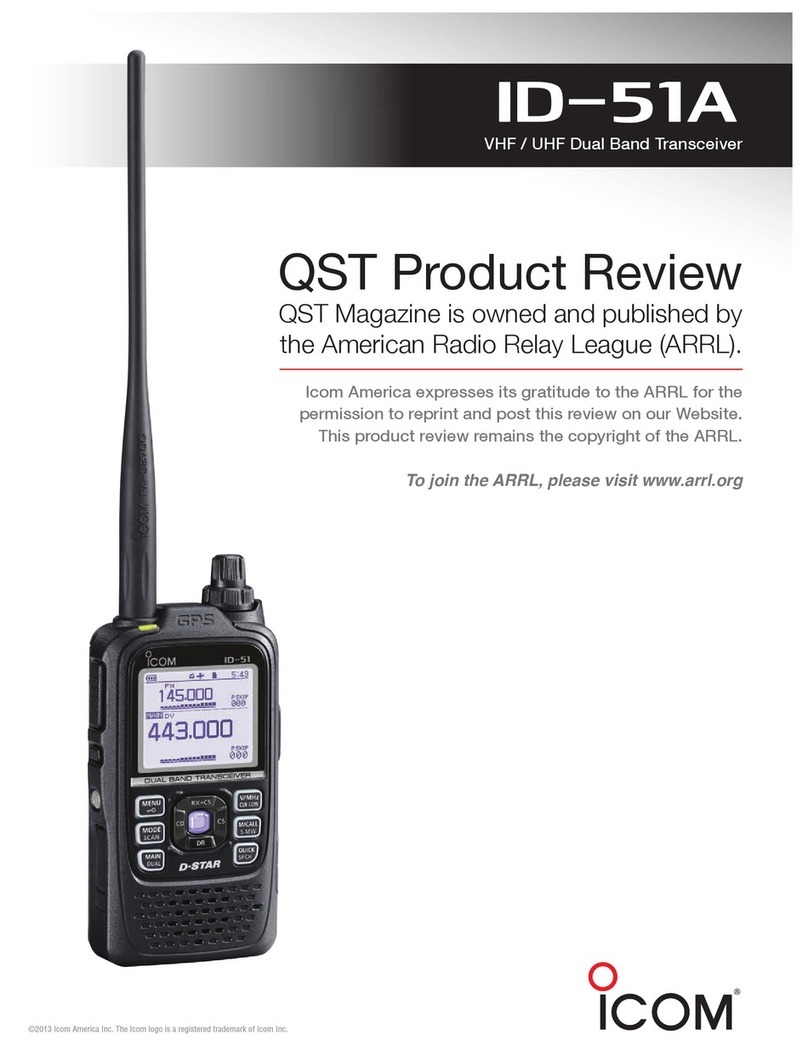
Icom
Icom ID-51A User manual

Icom
Icom IC-M87 User manual
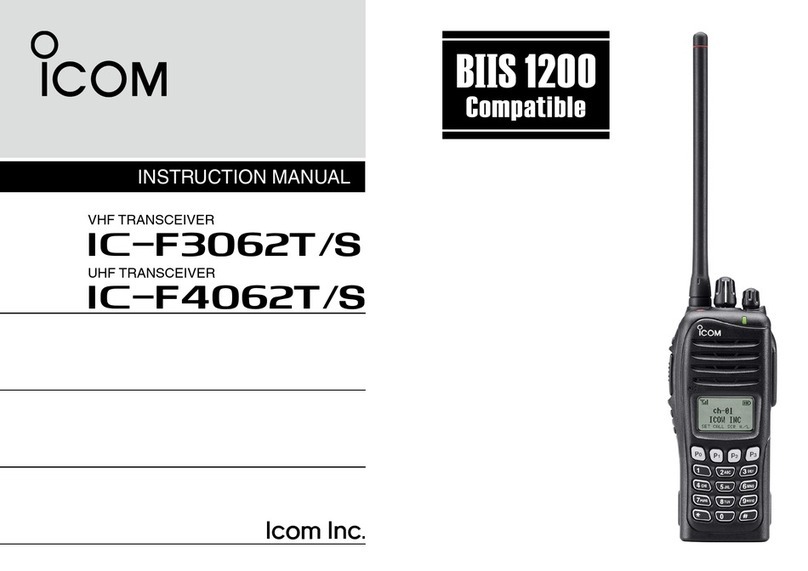
Icom
Icom IC-F3062T User manual
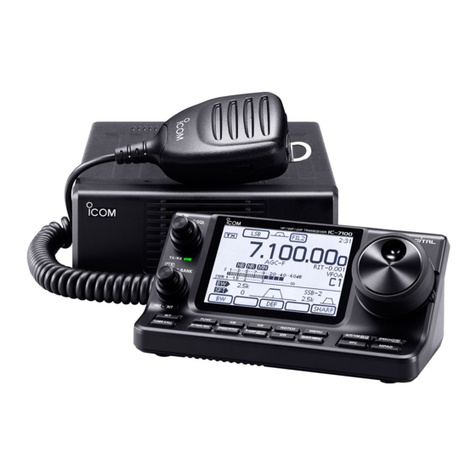
Icom
Icom IC-7100 Installation and operating instructions
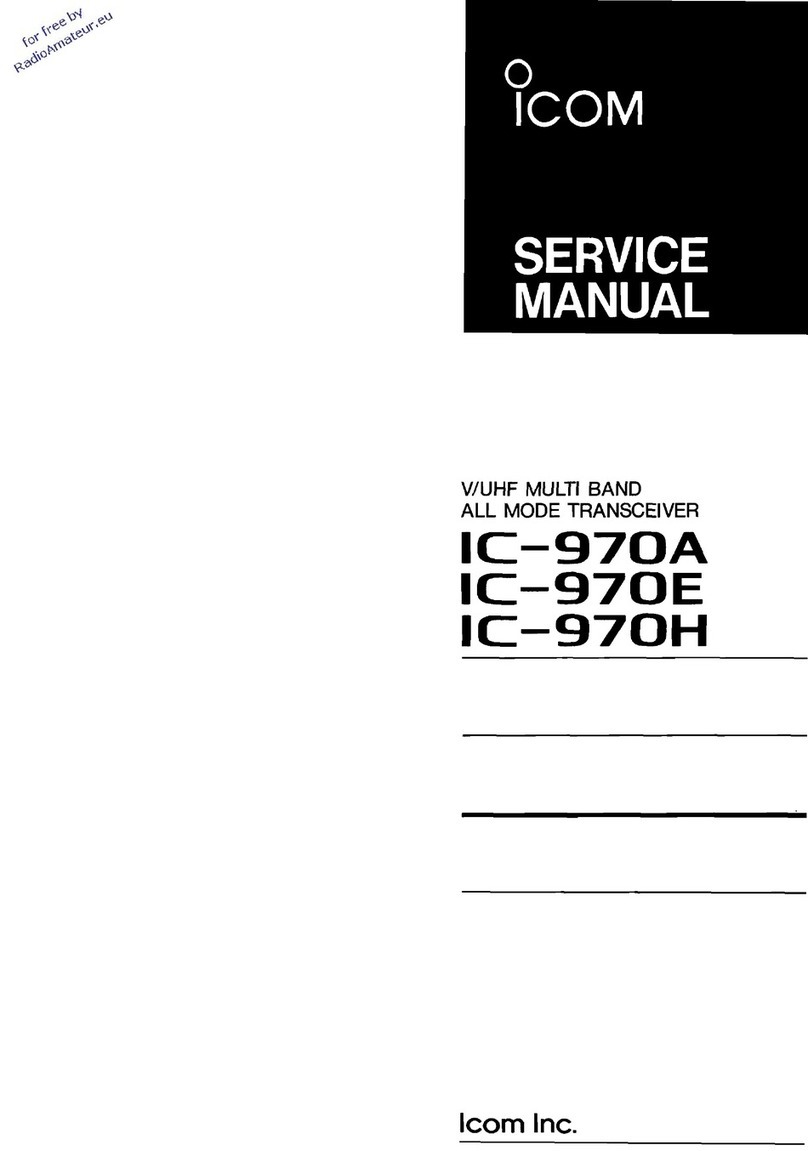
Icom
Icom IC-970A User manual
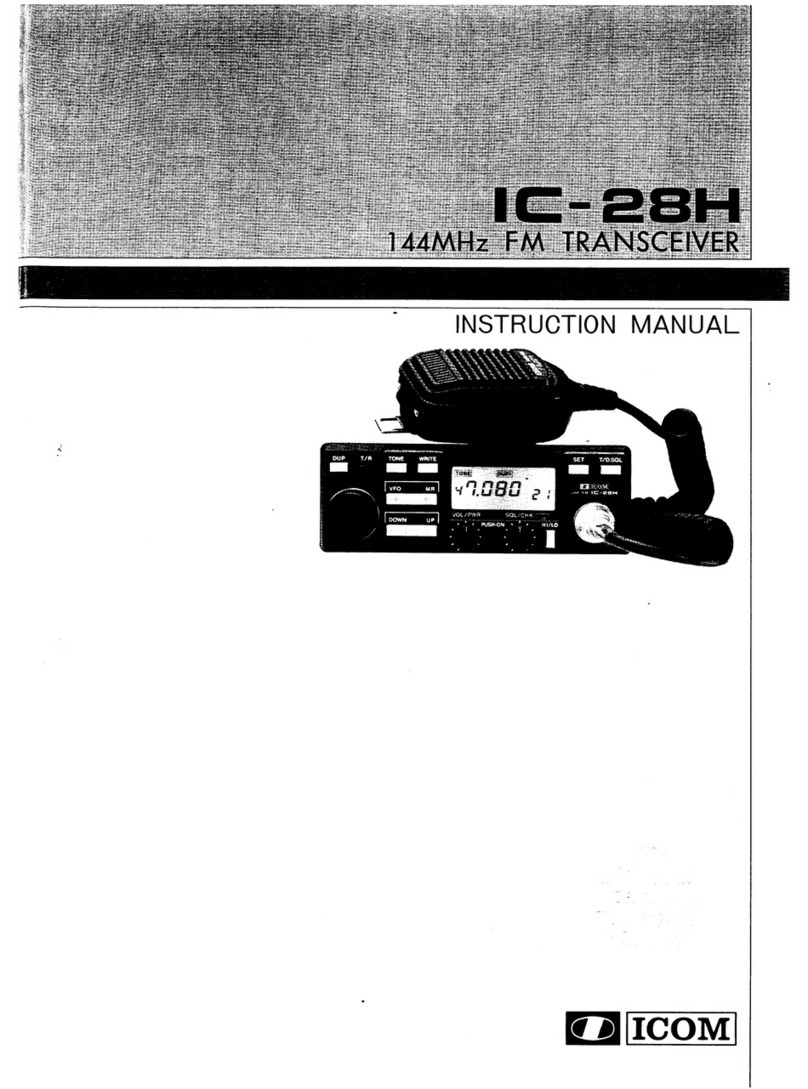
Icom
Icom IC-28H User manual
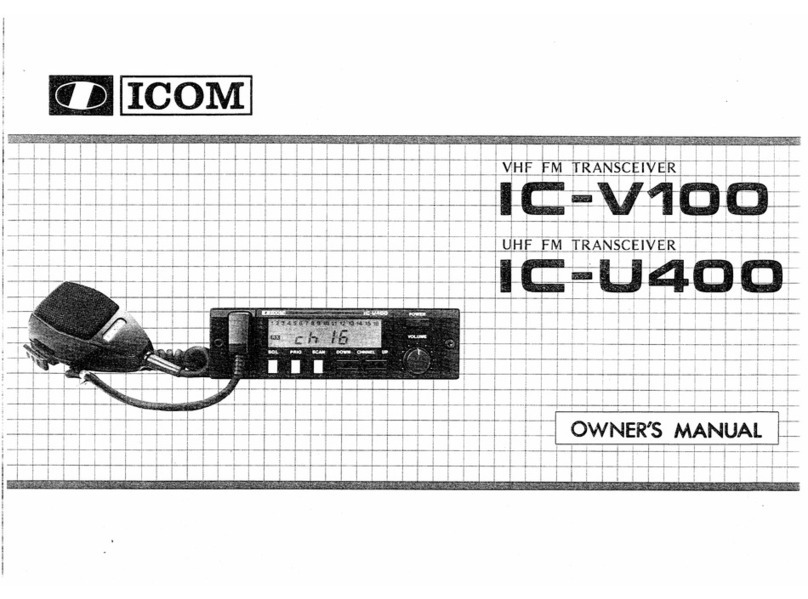
Icom
Icom IC-V100 User manual
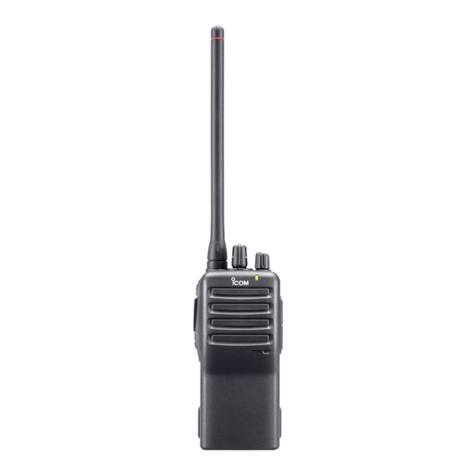
Icom
Icom IC-F15 User manual
